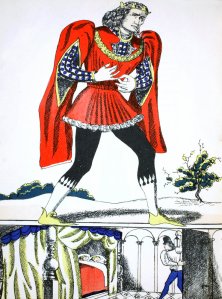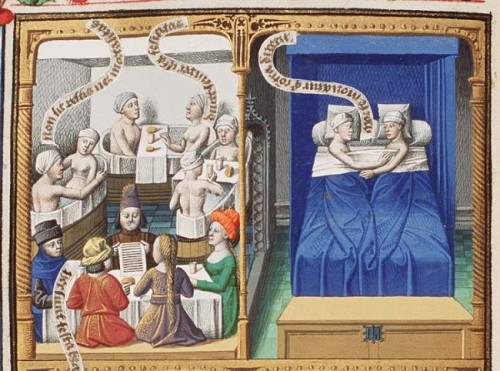 On an unusually beautiful morning of our perfect Indian summer I awoke feeling like the Mole in The Wind in The Willows, possessed of a great urge to get out of the house and do something a bit different. So I put up an egg sandwich and hopped on the first bus into Leicester to see for myself what is afoot with the remains of Richard III in the newly designated Cultural Quarter. The Cathedral is full of screens behind which they are digging out the grave in the crypt and then the new tomb will lie above in the nave. There’s a newly planted herb and flower garden outside graced by a statue of the last Plantagenet in Bosworth armour, with a spicy nip of catmint from beneath his mailed feet, but no alley cats to roll in it. This part of town has been greatly smartened up. That sharp scent in the clear silky air persuaded me to give the accompanying exhibition a miss: it’s permanent so no doubt I shall go eventually but it seemed to be too lovely a day to be indoors with all the flashing lights and booming sound effects. All museums have a certain airlessness about them, some of the most famous being the most oppressive. There are too many fast food cafes for one thing and too many sealed windows. It’s a new kind of stuffiness to that of the old days. I remember the smell of the old Leicester Museum in New Walk, just a few minutes’ stroll away from Richard. It is now greatly changed and modernised: the menagerie of stuffed animals which so entranced and secretly terrified me as a child have all gone. I realise now that the pungent odour that hung over everything then must have been some kind of embalming fluid: and maybe the emanations of the partially unwrapped bitumen-blackened mummies in a shadowy back gallery. Like a lot of Leicester people I can’t get too excited about King Richard in death. Our vicar thinks he should have been left alone in the privacy of his car park, not dug up to make a Roman holiday. I’m with her there. I think we have far too many exhumations in this modern craving for certainties. Exhumation is a dreadful and solemn thing, traditionally performed by the light of torches as though it were something shameful: the participants holding cologne-soaked cloths to their faces, and prayers said as spades jar against rotting wood and eternal stone. Nowadays it is all sanitised and glossed over by easy talk of DNA and glib scientific journalistic niceties. Poor old king, his bones all spread out on a table for the world’s press to peer at. How would Richard have smelled in life? Probably not that bad. The folk of the late middle ages were rather cleaner than their immediate descendants. They didn’t for one thing have the fear of washing and bathing which came on rather later due to cranky medical theories, sewage-polluted rivers and water-borne diseases. Medieval people liked hot baths, often taken communally. The habit had been brought back by the Crusaders, along with such expensive and desirable niceties such as soap, attar of roses, incense, spices, damask and silks. Jolly pictures of naked ladies in the bath show them still wearing their hennins, veils and cauls, the bare head still being regarded as the most erotic and private part of the anatomy.
On an unusually beautiful morning of our perfect Indian summer I awoke feeling like the Mole in The Wind in The Willows, possessed of a great urge to get out of the house and do something a bit different. So I put up an egg sandwich and hopped on the first bus into Leicester to see for myself what is afoot with the remains of Richard III in the newly designated Cultural Quarter. The Cathedral is full of screens behind which they are digging out the grave in the crypt and then the new tomb will lie above in the nave. There’s a newly planted herb and flower garden outside graced by a statue of the last Plantagenet in Bosworth armour, with a spicy nip of catmint from beneath his mailed feet, but no alley cats to roll in it. This part of town has been greatly smartened up. That sharp scent in the clear silky air persuaded me to give the accompanying exhibition a miss: it’s permanent so no doubt I shall go eventually but it seemed to be too lovely a day to be indoors with all the flashing lights and booming sound effects. All museums have a certain airlessness about them, some of the most famous being the most oppressive. There are too many fast food cafes for one thing and too many sealed windows. It’s a new kind of stuffiness to that of the old days. I remember the smell of the old Leicester Museum in New Walk, just a few minutes’ stroll away from Richard. It is now greatly changed and modernised: the menagerie of stuffed animals which so entranced and secretly terrified me as a child have all gone. I realise now that the pungent odour that hung over everything then must have been some kind of embalming fluid: and maybe the emanations of the partially unwrapped bitumen-blackened mummies in a shadowy back gallery. Like a lot of Leicester people I can’t get too excited about King Richard in death. Our vicar thinks he should have been left alone in the privacy of his car park, not dug up to make a Roman holiday. I’m with her there. I think we have far too many exhumations in this modern craving for certainties. Exhumation is a dreadful and solemn thing, traditionally performed by the light of torches as though it were something shameful: the participants holding cologne-soaked cloths to their faces, and prayers said as spades jar against rotting wood and eternal stone. Nowadays it is all sanitised and glossed over by easy talk of DNA and glib scientific journalistic niceties. Poor old king, his bones all spread out on a table for the world’s press to peer at. How would Richard have smelled in life? Probably not that bad. The folk of the late middle ages were rather cleaner than their immediate descendants. They didn’t for one thing have the fear of washing and bathing which came on rather later due to cranky medical theories, sewage-polluted rivers and water-borne diseases. Medieval people liked hot baths, often taken communally. The habit had been brought back by the Crusaders, along with such expensive and desirable niceties such as soap, attar of roses, incense, spices, damask and silks. Jolly pictures of naked ladies in the bath show them still wearing their hennins, veils and cauls, the bare head still being regarded as the most erotic and private part of the anatomy.  So Richard would have had his baths; washed his hair occasionally; dried and mopped himself with linen towels. All very necessary after being half boiled in a suit of armour all day whether in battle or for arms practice. Skin might be rubbed with bunches of herbs or with grains of musk; it was also rinsed, massaged and toned with primitive blends of what we should think of as eau de cologne – concoctions such as the 14th century Queen of Hungary Water, the European best-seller (to be taken internally, too) of rosemary, marjoram and pennyroyal. It was Richard’s clothes that caused problems: the damp of those stone castles must have permeated everything, despite being laid up in cedar chests and layered with dried rose petals and lavender. None of the garments apart from the shirts were washable; and underwear as such was unknown. The furs so essential for warmth were not all properly cured and the tanning processes of leather relied heavily on the use of human excrement. The most popular method to deter moth was the hanging of one’s clothes on poles above the open pit of the latrine. So you can see for yourselves that a certain whiffiness would have been only exacerbated by the attempted camouflage of civet, musk and ambergris. Picture the scene! The Tower, the sleeping Princes, the reeking bottled spider scuttling up the winding stair..but all that is another story…
So Richard would have had his baths; washed his hair occasionally; dried and mopped himself with linen towels. All very necessary after being half boiled in a suit of armour all day whether in battle or for arms practice. Skin might be rubbed with bunches of herbs or with grains of musk; it was also rinsed, massaged and toned with primitive blends of what we should think of as eau de cologne – concoctions such as the 14th century Queen of Hungary Water, the European best-seller (to be taken internally, too) of rosemary, marjoram and pennyroyal. It was Richard’s clothes that caused problems: the damp of those stone castles must have permeated everything, despite being laid up in cedar chests and layered with dried rose petals and lavender. None of the garments apart from the shirts were washable; and underwear as such was unknown. The furs so essential for warmth were not all properly cured and the tanning processes of leather relied heavily on the use of human excrement. The most popular method to deter moth was the hanging of one’s clothes on poles above the open pit of the latrine. So you can see for yourselves that a certain whiffiness would have been only exacerbated by the attempted camouflage of civet, musk and ambergris. Picture the scene! The Tower, the sleeping Princes, the reeking bottled spider scuttling up the winding stair..but all that is another story…
Aroma Folio
by Lemon Wedge
